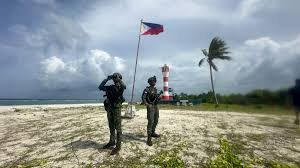Philippines: PonteSud – News Desk
Overwhelmed after setting foot for the first time on a far-flung but picturesque island in the disputed South China Sea, a Filipino army official knelt to kiss the shore. She held a small Philippine flag that fluttered in the breeze.
“This is just so beautiful,” Philippines military spokesperson Col. Francel Margareth Padilla said of West York Island, one of nine islands, reefs and atolls occupied by Filipino forces in the long-contested waters. “This solidifies our resolve to fight for this place whatever happens.”
The 18.6-hectare (46-acre) droplet-shaped island, called Likas by Filipinos, could easily become an eco-tourism draw in tropical Asia with its powdery white-sand beaches, turquoise waters and giant sea turtle sanctuaries. Padilla expressed hope it could someday be opened to Filipino travelers and tourists from across the world.
But that longstanding aspiration by Philippine officials has been stymied by a tangle of territorial conflicts involving a militarily superior China.
Beijing claims virtually the entire South China Sea, a vital global trade route with rich undersea deposits of gas and oil. It has increasingly flexed its military might, including its navy, the largest in the world, to strengthen its grip on a strategic waterway it says it has owned since ancient times.
The Philippines, Vietnam, Malaysia, Brunei and Taiwan contest China’s expansive claims with their own, and the territorial stand-offs have increasingly flared into cat-and-mouse confrontations at sea in recent years.
Both former President Joe Biden and his successor, Donald Trump, have condemned China’s growing aggression in the contested waters, including its coast guard’s use of powerful water cannons, blinding military-grade lasers and dangerous sea maneuvers against the coast guard and navy of the Philippines, Washington’s oldest treaty ally in Asia.
Under President Ferdinand Marcos Jr., who took office in mid-2022, the Philippines has intensified a campaign to expose China’s increasingly assertive actions by capturing them in video and photographs. The images have then been made public in the hope that international pressure would prompt Beijing to back down to avoid damage to its reputation.
The Philippine military invited a small group of journalists, including two from The Associated Press, in a dayslong naval patrol of the South China Sea territories claimed by Manila and on visits to navy and marine forces deployed to guard them.
During the patrol, which ended over the weekend, the BRP Andres Bonifacio navy ship carrying the journalists warned a number of Chinese coast guard ships and suspected Chinese militia vessels by two-way radio to move away from Philippines-claimed waters. The Chinese ships responded by asserting their sovereignty in the offshore region without undertaking any provocative actions.
On West York Island, two Filipino marines in camouflage uniforms stood guard with M4 assault rifles under a Philippine flag. One used binoculars to scan the surrounding waters for Chinese or Vietnamese ships passing by from a distance.
One of the farthest islands in the disputed waters from the nearest Philippine province of Palawan, West York is a difficult and risky post, where Filipino forces see nothing beyond the small island but sea. Military personnel can occasionally call their loved ones during their two-month deployment, but the internet connection is spotty, especially during the typhoon season that starts in June, according to military personnel on the island.
They grow eggplants, okra and chili peppers and raise goats and chickens to augment food provisions delivered by navy ships from Palawan. There is a makeshift basketball court to help while away off-duty time and ease the feeling of isolation.
More than a decade ago, China transformed seven disputed South China Sea reefs into island bases, where Chinese coast guard and navy ships can now refuel and obtain supplies for longer periods far from the Chinese mainland.
One of China’s artificial islands, Subi, has a military-grade runway and lies just 26 kilometers (16 miles) from Thitu.







